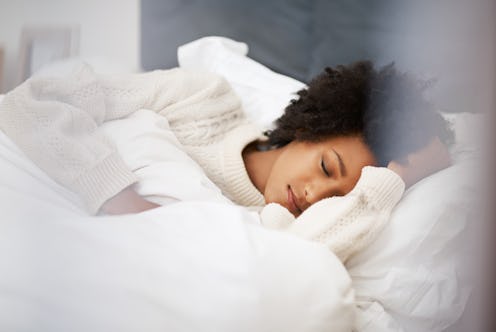Life
Experts Say To Look Out For This Sleep Condition If You Live Alone

You can probably remember the details a nightmare or two from your childhood that left you sitting up in bed, scared out of your wits. Nightmares tend to be vivid and hard to forget, no matter how much time passes by. On the other hand, people experiencing sleep terrors may have no recollection of these intense episodes of fear, screaming, thrashing, and sweating that can leave bystanders breathless, and not in a good way. Dealing with these sleep disruptions can mess with your sleep cycle, or in some cases, point to a more serious sleep disorder. If you live alone, experts say to look out for signs you're experiencing night terrors or sleep walking, so that you can seek out the advice of your physician on how to get your sleep troubles under control.
According to the American Sleep Association, sleep terrors and sleepwalking are both classified as “parasomnias,” which refer to “general sleep disruptions from the REM (rapid eye movement) sleep cycle and non-REM sleep cycles.” Though they're much more likely to affect children, the American Academy of Sleep Medicine (AASM) reported that an estimated 2.2% of adults experience sleep terrors. What’s more, according to the AASM, genetics play a large role in determining whether or not you are likely to experience sleep terrors. Sleep terrors are also linked to sleep deprivation, migraines, stress, certain mental health conditions, drinking alcohol, and even travel. Though sleep terrors are also commonly referred to as night terrors, they can occur whenever you lay down to rest, including when you take an afternoon nap.
Dr. Roy Raymann, PhD, vice president of Sleep Science and Scientific Affairs at SleepScore Labs, tells Bustle that sleep terrors normally happen during deepest stage of NREM [non-rapid eye movement] sleep, or stage N3. According to the National Sleep Foundation, stage N3 sleep is when your body repairs tissues and muscles, your immune system gets a boost, and you accumulate energy for the following day. According to a 2018 article published in Current Biology, sleepwalking and sleep terrors frequently co-occur, and sleepwalking also takes place during the N3 stage of sleep. Terrors, naturally, can be very disruptive to this deep, restorative sleep.
“Sleep terror episodes present as a partial awakening during sleep when a person exhibits an intense fear, terror, screaming, sweating, flushing, heart racing, and rapid breathing. Eyes are typically wide open, but have a glazed over appearance,” Dr. Lauren Goldman, MD, a physician at the Cleveland Clinic Sleep Disorders Center, says. She adds that, “During these events, a person can be disoriented, have incoherent speech, and can be difficult to console. Episodes can last up to 30 minutes in some cases.
Despite how severe sleep terrors can be, the person experiencing this parasomnia likely will not be aware of the event when it’s happening, or remember it after they wake up. Oftentimes, it’s someone in the household who first witnesses this terrifying-looking event, and tells their loved one what’s going on. That means living by yourself can make it difficult to identify if you’re having sleep terrors.
Dr. Raymann explains that someone having sleep terrors may find that their “bed or room is excessively disturbed in the morning.” Kicking and thrashing related to the sleep terrors can be the culprit behind a messy bedroom (that was clean before you snoozed) or broken lamp, but sleepwalking paired with sleep terrors is another common cause. “Someone who sleepwalks may wake up in a different location than where they fell asleep, or someone with sleep eating may wake up surrounded by crumbs and wrappers," Dr. Goldman says. Around 10% of sleepwalkers engaged in eating episodes, according to one study published in 2012.
Though Dr. Goldman and Dr. Raymann say that grogginess in the A.M. isn’t common following a sleep terror episode, it can’t be completely ruled out. Dr. Goldman says that when parasomnias such as sleep terrors and sleepwalking are frequent, excessive daytime fatigue can be caused by the constant disruption to sleep.
While consulting with your physician is always a good idea if you believe you’re experiencing sleep terror episodes, they typically don’t require any sort of medical attention or treatment. As a 2012 study reported, some evidence has shown anti-anxiety medications, antidepressants, and cognitive behavioral therapy (CBT) may help with sleep terrors. In most cases, Dr. Raymann explains simply practicing good sleep hygiene — maintaining a healthy sleep-wake cycle, creating a comfortable sleeping environment, exercising, limiting your alcohol intake, and capping your daytime naps at 30 minutes — can keep sleep terrors at bay. Dr. Goldman says your doctor might recommend an overnight sleep study if they think you might be at risk for obstructive sleep apnea or seizures.
If you suspect you’re experiencing sleep terrors and you live alone, you can sleuth and set up your iPhone camera to try to catch yourself in an active sleep terror or sleepwalking episode at night. Or, just try to look for the consistent clues — like having a messy bedroom paired with waking up in a different area of your apartment. Parasomnias like sleep terrors can be tricky to detect when you live in your own space, but know what signs to look for can help you sleep soundly in no time.
Sources Interviewed:
Dr. Roy Raymann, PhD, vice president of Sleep Science and Scientific Affairs at SleepScore Labs
Dr. Lauren Goldman, MD, a physician at the Cleveland Clinic Sleep Disorders Center
Studies Referenced:
Arnulf, I. (2018). Sleepwalking. Current Biology, 28(22). doi: 10.1016/j.cub.2018.09.062
Attarian, H., & Zhu, L. (2013). Treatment options for disorders of arousal: a case series. International Journal of Neuroscience, 123(9), 623–625. doi: 10.3109/00207454.2013.783579
Brion, A., Flamand, M., Oudiette, D., Voillery, D., Golmard, J.-L., & Arnulf, I. (2012). Sleep-related eating disorder versus sleepwalking: A controlled study. Sleep Medicine, 13(8), 1094–1101. doi: 10.1016/j.sleep.2012.06.012
This article was originally published on